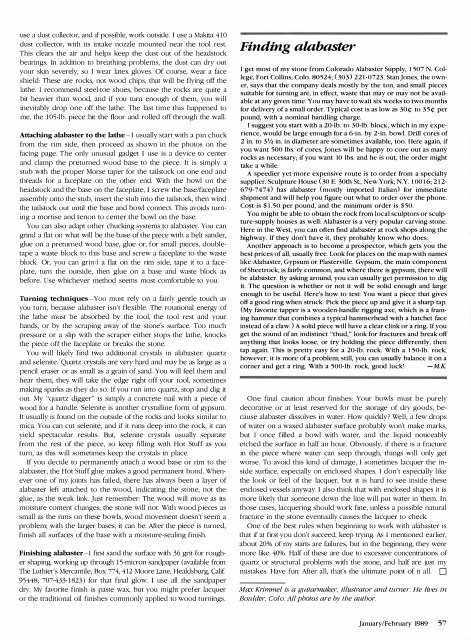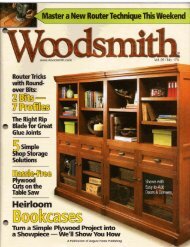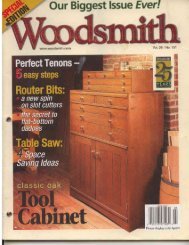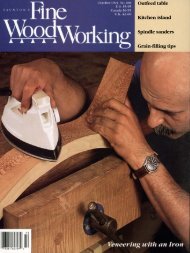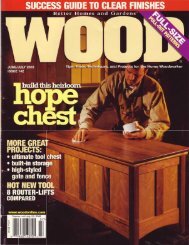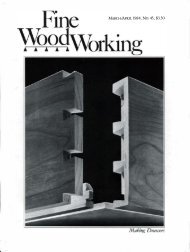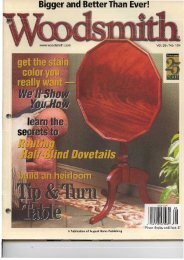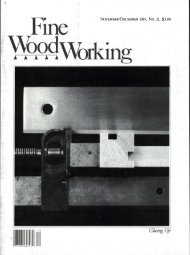Untitled - MetosExpo - Free
Untitled - MetosExpo - Free
Untitled - MetosExpo - Free
You also want an ePaper? Increase the reach of your titles
YUMPU automatically turns print PDFs into web optimized ePapers that Google loves.
use a dust collector, and if possible, work outside. I use a Makita 410dust collector, with its intake nozzle mounted near the tool rest.This clears the air and helps keep the dust out of the headstockbearings. In addition to breathing problems, the dust can dry outyour skin severely, so I wear latex gloves. Of course, wear a faceshield: These are rocks, not wood chips, that will be flying off thelathe. I recommend steel-toe shoes, because the rocks are quite abit heavier than wood, and if you turn enough of them, you willinevitably drop one off the lathe. The last time this happened tome, the lOS-lb. piece hit the floor and rolled off through the wall.Attaching alabaster to the lathe - I usually start with a pin chuckfrom the rim side, then proceed as shown in the photos on thefacing page. The only unusual gadget I use is a device to centerand clamp the preturned wood base to the piece. It is simply astub with the proper Morse taper for the tailstock on one end andd1reads for a faceplate on the other end. With the bowl on d1eheadstock and the base on the faceplate, I screw the base/faceplateassembly onto the stub, insert the stub into the tailstock, then windthe tailstock out until the base and bowl connect. This avoids turninga mortise and tenon to center the bowl on the base.You can also adapt other chucking systems to alabaster. You cangrind a flat on what will be the base of the piece with a belt sander,glue on a preturned wood base, glue or, for small pieces, doubletapea waste block to d1is base and screw a faceplate to the wasteblock. Or, you can grin I a flat on the rim side, tape it to a faceplate,turn the outside, then glue on a base and waste block asbefore. Use whichever method seems most comfortable to you.Turning techniques -You must rely on a fairly gentle touch asyou turn, because alabaster isn't flexible. The rotational energy ofthe lathe must be absorbed by the tool, the tool rest and yourhands, or by the scraping away of d1e stone's surface. Too muchpressure or a slip with the scraper either stops the lathe, knocksthe piece off the faceplate or breaks the stone.You will likely find two additional crystals in alabaster: quartz 'and selenite. Quartz crystals are very hard and may be as large as apencil eraser or as small as a grain of sand. You will feel them andhear them; they will take the edge right off your tool, sometimesmaking sparks as d1ey do so. If you run into quartz, stop and dig itout. My "quartz digger" is simply a concrete nail with a piece ofwood fo r a handle. Selenite is anod1er crystalline fo rm of gypsum.It usually is found on the outside of the rocks and looks similar tomica. You can cut selenite, and if it runs deep into d1e rock, it canyield spectacular results. But, selenite crystals usually separatefrom the rest of the piece, so keep fi lling with Hot Stuff as youturn, as this will sometimes keep d1e crystals in place.If you decide to permanently attach a wood base or rim to thealabaster, the Hot Stuff glue makes a good permanent bond. Wheneverone of my joints has failed, there has always been a layer ofalabaster left attached to the wood, indicating the stone, not theglue, as d1e weak link. Just remember: The wood will move as itsmoisture content changes; the stone will not. Wid1 wood pieces assmall as the rims on d1ese bowls, wood movement doesn't seem aproblem; with d1e larger bases, it can be. After the piece is turned,finish all surfaces of d1e base with a mOisture-sealing finish.Finishing alabaster-I first sand the surface with 36 grit for roughershaping, working up d1rough IS-micron sandpaper (available from111e Luthier's Mercantile, Box 774, 412 Moore Lane, Healdsburg, Calif.95448; 707-433-1823) for that final glow. I use all the sandpaperdry. My favorite finish is paste wax, but you might prefer lacqueror d1e traditional oil finishes commonly applied to wood turnings.Finding alabasterI get most of my stone from Colorado Alabaster Supply, 1507 N. College,Fort Collins, Colo. 80524; (303) 221-0723. Stan Jones, the owner,says that the company deals mostly by the ton, and small piecessuitable for turning are, in effect, waste that may or may not be availableat any given time. You may have to wait six weeks to two monthsfor delivery of a small order. Typical cost is as low as 30¢ to 35¢ perpound, with a nominal handling charge.I suggest you start with a 20-lb. to 30-lb. blOCK, which in my experience,would be large enough fo r a 6-in. by 2-in. bowl. Drill cores of2 in. to Y/2 in. in diameter are sometimes available, too. Here again, ifyou want 500 lbs. of cores, Jones will be happy to core out as manyrocks as necessary; if you want 10 Ibs. and he is out, the order mighttake a while.A speedier yet more expensive route is to order from a specialtysupplier. Sculpture House (30 E. 30th St., New York, N.Y. 10016; 212-679-7474) has alabaster (mostly imported Italian) for immediateshipment and will help you figure out what to order over the phone.Cost is S1.50 per pound, and the minimum order is S50.You might be able to obtain the rock from local sculptors or sculpture-supplyhouses as well: Alabaster is a very popular carving stone.Here in the West, you can often find alabaster at rock shops along thehighway. If they don't have it, they probably know who does.Another approach is to become a prospector, which gets you thebest prices of all, usually free. Look for places on the map with nameslike Alabaster, Gypsum or Plasterville. Gypsum, the main componentof Sheetrock, is fairly common, and where there is gypsum, there willbe alabaster. By asking around, you can usually get permission to digit. The question is whether or not it will be solid enough and largeenough to be useful. Here's how to test: You want a piece that givesoff a good ring when struck. Pick the piece up and give it a sharp tap.(My favorite tapper is a wooden-handle rigging axe, which is a framinghammer that combines a typical hammerhead with a hatchet faceinstead of a claw. ) A solid piece will have a clear clink or a ring. If youget the sound of an indistinct "thud," look for fractures and break offanything that looks loose, or try holding the piece differently, thentap again. This is pretty easy for a 20-lb. rock. With a 150-lb. rock,however, it is more of a problem; still, you can usually balance it on acorner and get a ring. With a 500-lb. rock, good luck! -MKOne final caution about finishes: Your bowls must be purelydecorative or at least reserved fo r the storage of dry goods, becausealabaster dissolves in water. How quickly ? Well, a few dropsof water on a waxed alabaster surface probably won't make marks,but I once filled a bowl wid1 water, and d1e liquid noticeablyetched the surface in half an hour. Obviously, if there is a fracturein the piece where water can seep through, things will only getworse. To avoid this kind of damage, I sometimes lacquer the insidesurface, especially on enclosed shapes. I don't especially liked1e look or feel of the lacquer, but it is hard to see inside theseenclosed vessels anyway. I also think that with enclosed shapes it ismore likely that someone down the line will put water in them. Ind10se cases, lacquering should work fine, unless a possible naturalfracture in the stone eventually causes the lacquer to check.One of the best rules when beginning to work with alabaster isthat if at first you don't succeed, keep Hying. As I mentioned earlier,about 20% of my starts are failures, but in the beginning, they weremore like 40%. Half of these are due to excessive concentrations ofquartz or structural problems with the stone, and half are just mymistakes. Have fun: After all, dut's the ultimate point of it all. 0Max Klimmel is a gUitar-maker, illustrator and tumer. He lives inBoulder, Colo. All pbotos are by tbe autbor.January/February 1989 57


